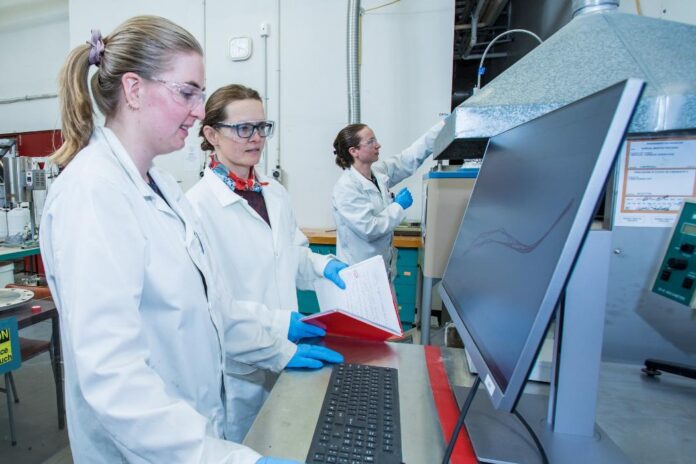Source: University of Canterbury
11 June 2021
Cutting-edge research into obtaining tech-critical metals from mixed oxides could play an important role in helping Aotearoa New Zealand transition to a zero-carbon country.
-
Associate Professor Catherine Bishop (centre) and Chemical and Process Engineering postgraduates in the Special Purposes Laboratory. Associate Professor Bishop discusses voltammetry results with Rebecca Newport (left) while Kathryn Ford (right) prepares the ultra-high temperature electrolysis cell for an experiment.
The transdisciplinary team, led by University of Canterbury (UC) Associate Professor Catherine Bishop, integrates experts in Materials Science and Engineering, Chemical and Process Engineering, and Minerals processing.
The research is focused on the processing of tantalum, a hard to process metal; and neodymium, a rare earth metal, in the initial proof-of-concept stage. These are used in capacitors and magnets, including the magnets that are a key component in almost all wind turbines.
While most research in this area focuses on water or salt solutions, Associate Professor Bishop says this process is unique because it would be an all-oxide, electrochemical route.
“The processing routes for these metals are usually multi-stage and involve low efficiency, hazardous solvent and acid treatments. However, we hypothesise that an all-oxide route will mitigate the low efficiency and environmental toll of obtaining these, and related, metals.
“Developing a new, carbon-free route to obtaining these critical metals will, with further innovation, be a means to achieving New Zealand’s low carbon goals; securing access to these metals has also been identified as essential for achieving equitable transition to low carbon goals by the International Energy Agency.
“If we are able to secure funding and the science results are promising, we would then aim at building a 10 kg/day pilot plant to show that our process works outside the lab.”
For New Zealand, the economic benefits of this research are also significant, with the potential for new metal production industries to be established based on this science.
“This research presents a very real opportunity for New Zealand, particularly for regional development,” says Associate Professor Bishop.
“Rare earth ores have been identified on the West Coast of the South Island, with work in progress by the New Zealand Institute for Minerals to Materials Research to quantify the chemistry, quality, and distribution of these potential deposits. If viable deposits are identified, then these ores could be processed by our science route.
“There may also be opportunities for the Māori economy with the co-development of processing plants located by renewable energy generation or for direct investment in new companies.”



